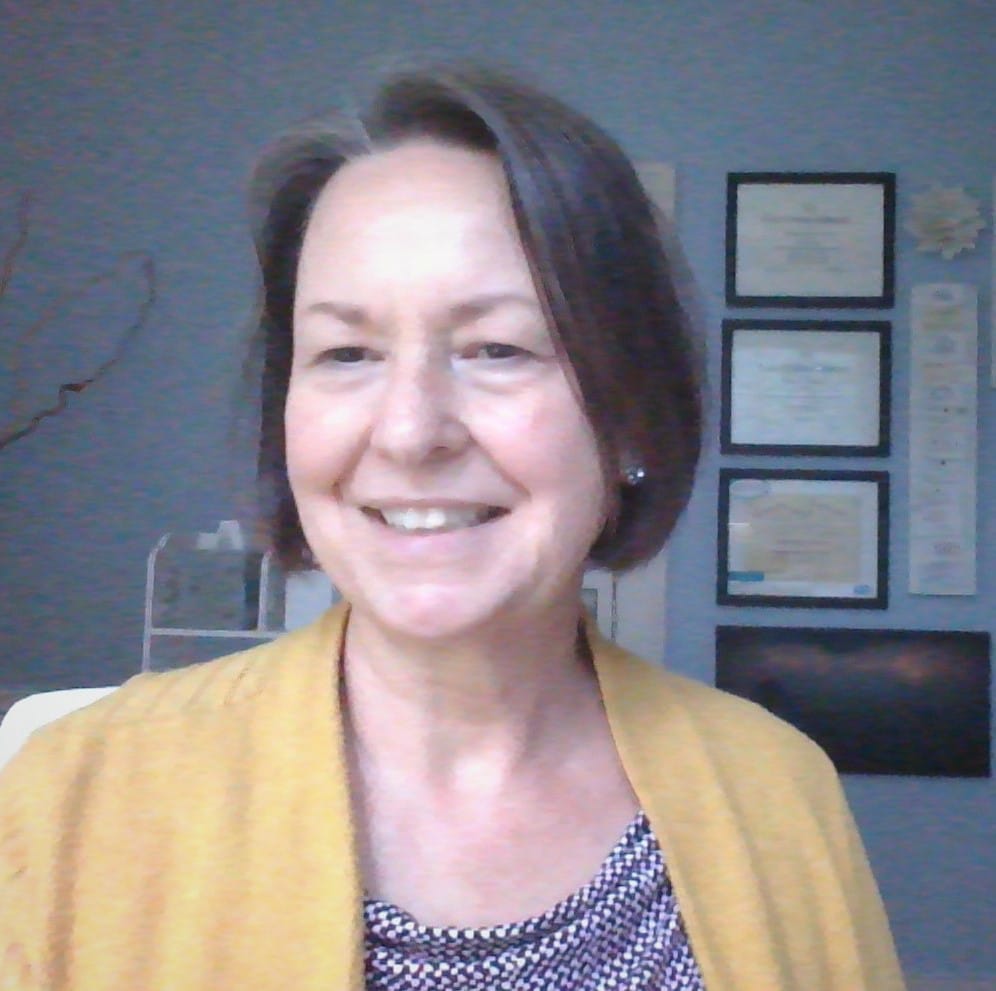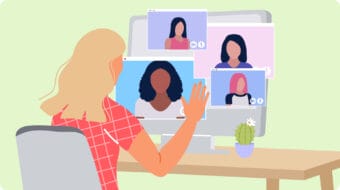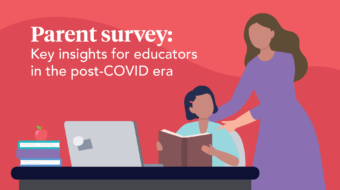
Barbara Jones, M.S., CCC-SLP, grew up in the Washington, D.C. area. She went to college in Texas where she met her husband. They lived in Texas for 9 years after graduate school and then moved to Arkansas where they’ve lived ever since. About her home state, Barbara told us, “Arkansas is a well kept secret. It’s really a beautiful place and not too big and not too busy. It’s just about right.”
What do you and your husband do outside of work?
We have 3 children and 2 grandchildren. Outside of work I spend a lot time doing volunteer work. I work a lot with Young Life, an outreach organization to adolescents. So sometimes I’m spending my outside time with college kids—that’s the area of adolescence that I really enjoy—meeting with them one-on-one or having dinners for them. The rest is working around the house, doing a little arts and crafts. I love to read.
What inspired you to become an SLP?
I became an SLP because I wanted to do something in the special education arena. I didn’t think I wanted to teach in a classroom. I have a wonderful sister. At the time, she published articles for the Occupational Outlet Handbook that’s put out by the Bureau of Labor Statistics to tell you what your career is going to look like in the future. She found speech language pathology and told me about it. I thought it sounded great so I was in from that point on.
What made you want to be a teletherapist with PL?
I was ready to skip the commute and work from home. PL seemed to have the best support system and also had room for advancement. I am now a lead clinician.
Could you walk us through your daily routine? A “day in the life of a PL therapist” if you will?
First thing in the morning I check and reply to emails. I organize my desk and “room” for the day’s PL sessions. I am often able to fit an errand or task into my day in between sessions. Since I work three time zones away, I usually have to jump up right after my last session to start dinner, but there is no commute time!
What time zones are you serving and how do you keep track of that?
For PL I am only serving the Alaska time zone this year. So that is fairly easy because their school day doesn’t start until 12 o’clock my time except for one student I am serving separately because his parents asked for him to be served before school so I see him a little earlier. I can get other things done on the early side. I do some other contract work, not teletherapy but something a little different in the mornings with the East Coast, so I get to see East Coast people in the mornings and then I switch over to my Alaska people. It makes for a long day but it’s working out pretty well.
Can you tell us about your caseload?
I’m serving pre-K through high school. The oldest student I have this year is in 8th grade. I’m seeing everyone from a fairly established elementary school and town (they drive cars and have a school bus), to a town that’s on an island that’s inaccessible except by ferry. They don’t have cars. They drive four wheelers and skiffs. That’s my most interesting town. This little town has two preschoolers who are on the autism spectrum. I was able to help them get diagnoses. It was really great to be able to get services started for them with the help of the district psychologist. So that was a real privilege.
One of my other schools is a Tlingit Indian Cultural School. They teach the Tlingit language, and I’ve learned some things about the culture. That’s been really interesting as well.
All of my towns have to be traveled to by ferry—it’s one district but they’re not close to each other time-wise. Prior to PresenceLearning, the students had a quarterly one-day visit from an SLP. And in that one day, they assessed progress and trained paraprofessionals how to do the speech therapy. As you might imagine, when PL took over and I came on board, it was a disproportionate caseload because the students weren’t making a lot of progress. It’s been a pleasure over these 3 years to be able to dismiss several kids because they’ve actually had therapy and they’ve actually met goals. It really makes me feel good and useful to serve areas that would not have an SLP if I weren’t serving through PL.
Can you explain what is different about being a lead clinician and how long you were with PL before stepping into that role?
When I was considering leaving the university where I was a clinical instructor, I thought about going into private practice and I went to ASHA.org and checked into some courses on starting a private practice. One thing it mentioned was the possibility of using teletherapy as a fill-in while you’re building up your private practice. I thought Hmm…I was already interested in it because I had received several email ads from PL and other teletherapy companies. I had thought of just taking on a few hours when I was a clinical instructor so I could orient my students to teletherapy and what it was like. And so, after researching a few different companies, I started working with PL and I really learned to love it. I decided I was very happy with teletherapy and I didn’t need to develop my own local practice. I really do love it.
I’m excited about it enough to want to pass on that enthusiasm to school districts and to other providers and that’s what pushed me into wanting to do the lead clinician position. I worked with PL for two and a half years before I applied for the lead position. Lead clinicians support the providers in different areas or districts and you help support the districts that they serve—you are a liaison between those two. Leads help facilitate the scheduling as well.
Shortly after I got the lead position I was asked to come back on as a clinical instructor at a nearby university part-time. So now I’m a lead clinician for one town with 3 students. I have a wonderful provider there that I work with and I’m loving that. Next year I will take on more lead responsibilities.
What do you enjoy about being a provider with PL?
I like the network of providers and the avenues of communication that we have. I love the flexibility of choosing how many hours I work. The most exciting thing about working for PL is being able to serve students in remote areas who would not otherwise be receiving weekly services.
Can you tell me a little about any benefits you experience of having larger network of providers to work with?
I really enjoy being able to go into the online Lounge and see different comments from different providers. I enjoy the fact that sometimes people other than SLPs share their thoughts. I love that we share therapy ideas, I love that we share problems and help each other come up with solutions. Between that and having good leads, the lines of communication are very open.
Before teletherapy, I was 19 years with the same school district in the same school. We were so large. There were about 50 providers and we were spread out over a very large district. I had the privilege of working in a school where there were 2 other SLPs who came and went from other campuses. But even with that, we barely had time to talk to each other. So we didn’t get to share problems very often, or help each other out, or support each other. We were fairly isolated even when we were in the same school.
What were you most surprised about when you made the transition to be a teletherapist?
I was surprised how much more relaxed I was working from a home office.
What do you find most challenging about being a teletherapist?
Sometimes I wish I could still be in the room with the students that I am serving.
What’s one piece of advice you would offer a therapist who’s considering transitioning to telepractice?
Besides having a remote camera and two monitors which is my biggest practical piece of advice, my advice would be to Go for It! If you have had experience in other aspects of our profession, teletherapy is a great way to make a change and still be a full participant in the profession.
Anything else you’d like to add?
I think it’s exciting that we are on the cutting edge of something that’s very new. I didn’t get in on the very beginning of teletherapy, but it’s still new. There’s so much growth that can still happen and so many innovations that haven’t even been thought of yet. It’s just very exciting to be a part of that. And that’s one reason the University of Arkansas for Medical Sciences asked me to come do clinical instruction to give graduate students an idea of what teletherapy is and pass on some enthusiasm for that because it will be a big part of their world. It makes it very exciting to be a part of something that’s new and that’s so useful in the country and across the world.
Are you interested in joining the PL Care Network? Visit our Provider page to submit your application today!



